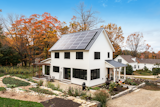Solar Arrays and Good Insulation Make These Prefab Residences Net-Zero—Even in Cold Climates
Welcome to Prefab Profiles, an ongoing series of interviews with people transforming how we build houses. From prefab tiny houses and modular cabin kits to entire homes ready to ship, their projects represent some of the best ideas in the industry. Do you know a prefab brand that should be on our radar? Get in touch!
In 2008, the small town of Rockport, Maine, had a local celebrity: a net-zero home called the BrightBuilt Barn. The property was named the most innovative home project of the year by the U.S. Green Building Council, later became the subject of a documentary, and seemed to exemplify a future where homes could be high-tech without feeling cold. The barn was super insulated and had solar panels that made it off-grid capable, but it blended in with every other home in the area.
That net-zero, LEED-platinum property would mark the beginning of BrightBuilt Home, a prefab company that takes the ethos of the Barn and applies it to 20 different models. "BrightBuilt is a mission-based company," says Jessica Richards, the company’s head of marketing and operations. "Our goal is not only to offer well-designed, climate-responsible homes using off-site construction methods, but to disrupt the residential design and construction industry. We want to build more net-zero, climate resilient homes for more people." Here, Richards shares more about how BrightBuilt Home is trying to defy industry—and homeowner—expectations.
What qualities make your prefab stand apart from the rest?
We design high-performance, net-zero, modular residences. We advocate for using existing modular manufacturing infrastructure to deliver high-performance homes to the market.
"The idea was to deliver off-the-shelf, high-performance homes at affordable prices and on faster timelines," says Jessica Richards, BrightBuilt’s head of operations and marketing.
What does your base model cost and what does that pricing include?
We have 20 base model designs that range from 420 to 2,700 square feet. Typical costs range from $450 to $600 per square foot, which includes, for example, site work, outbuildings, and garages. We consider these to be turnkey costs because it captures the true amount of everything to build a move-in ready structure, from earthwork and foundation to doorknobs and hardware.
Where are the prefabs currently available?
Currently, we have manufacturing partners in Maine, New Hampshire, and Pennsylvania, which allows us to serve all of New England, the Mid-Atlantic, and as far west as Ohio. Our company is based in Portland, Maine.
Is your design currently pre-permitted in any U.S. municipalities?
We are currently advocating for legislation in Maine to offer pre-approved accessory dwelling unit (ADU) designs. We hope to offer homes nationwide in the future.
Homes are built in 12 to 18 months, depending on the scale of the project. ADUs typically come together more quickly.
How long can a client expect the process to take after they put down a deposit?
Once we receive a deposit, the process typically takes 12 to 18 months from design kickoff to move-in. This includes four to six months of design and six to eight months of construction. ADUs can be delivered on a shorter arc, depending on the criteria and needs of the project.
What aspects of an install do you manage?
We manage all aspects of the design process, from design development to contractor and manufacturer pricing. We also facilitate communication through to completion of the home, so everyone is on the same page.
The company breaks its offerings into four distinct tiers, from a fixed set of options to more flexible ones.
The company oversees the entire design process, and facilitates communication between all involved parties.
What aspects of the design can a client customize?
We offer four design pathways so that clients can select how much they want to customize. Our first tier, the To Go pathway, offers one set design with four kitchen options, three rooflines, two window options, and three finishes palette options. Our second tier, the Ready pathway, offers a choice between three different versions of each of the 20 existing base model designs, including the customization of finishes.
Our third tier, the Tailored pathway, offers the 20 base designs as a starting point and any customized architectural and finishes options that do not break the footprint of the chosen design. Our last tier is the Custom pathway, where we will design anything in any style, within the parameters and geometries of modular manufacturing.
Prefab Profiles:
Method Homes Makes Bespoke Prefabs That Don’t Have a Factory Feel
This Prefab Builder Is Making Homes That Are Designed to Keep You Healthy
Published
Last Updated
Stay up to Date on the Latest in Prefab Homes
From cozy cottages to large family houses, see how prefab continues to redefine the future of construction, building, and design.







